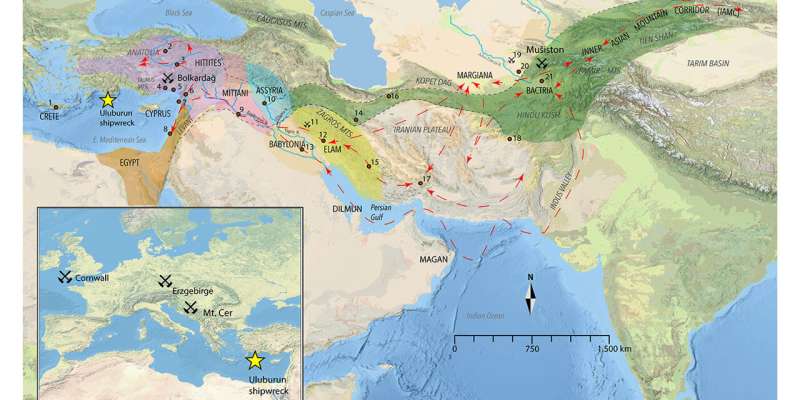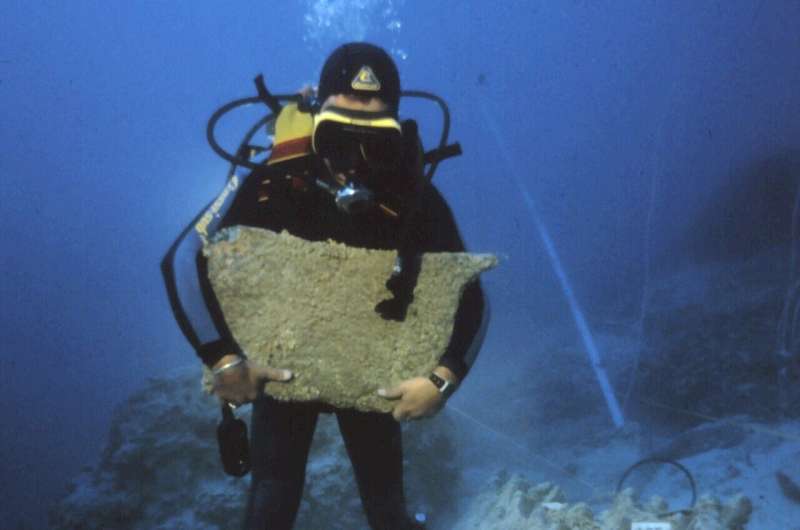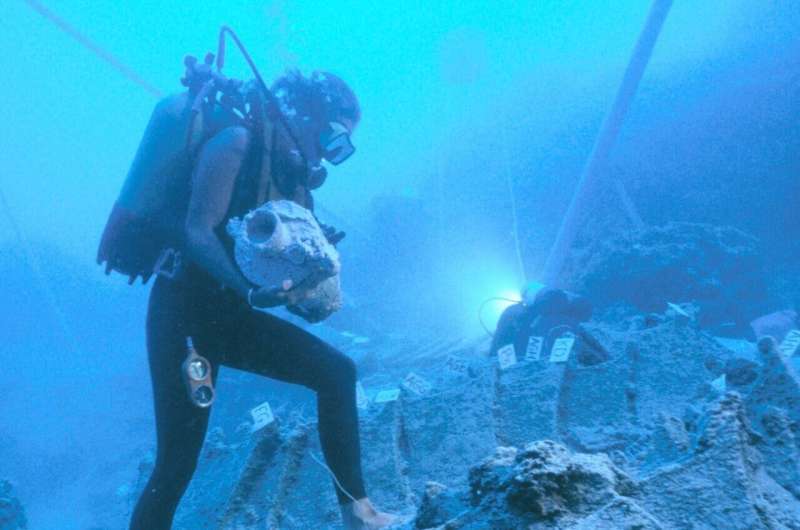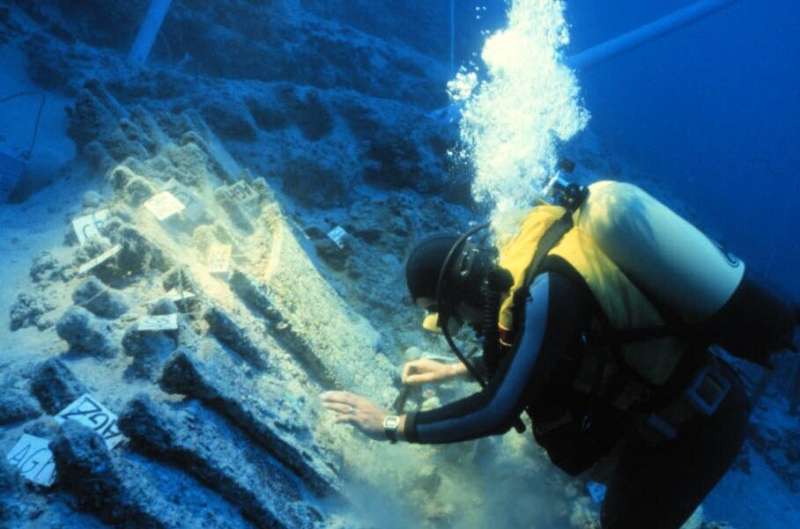
Tin from the Mušiston mine in Central Asia’s Uzbekistan traveled greater than 2,000 miles to Haifa, the place the ill-fated ship loaded its cargo earlier than crashing off the jap shores of Uluburun in present-day Turkey. Credit score: Map supplied by Michael Frachetti/Washington College in St. Louis
Greater than 3,000 years earlier than the Titanic sunk within the North Atlantic Ocean, one other well-known ship was wrecked within the Mediterranean Sea off the jap shores of Uluburun—in present-day Turkey— carrying tons of uncommon steel. Since its discovery in 1982, scientists have been finding out the contents of the Uluburun shipwreck to realize a greater understanding of the individuals and political organizations that dominated the time interval often called the Late Bronze Age.
Now, a workforce of scientists, together with Michael Frachetti, professor of archeology in Arts & Sciences at Washington College in St. Louis, have uncovered a shocking discovering: small communities of highland pastoralists residing in present-day Uzbekistan in Central Asia produced and provided roughly one-third of the tin discovered aboard the ship—tin that was en path to markets across the Mediterranean to be made into coveted bronze steel.
The analysis, printed on November 30 in Science Advanceswas made attainable by advances in geochemical analyzes that enabled researchers to find out with high-level certainty that a number of the tin originated from a prehistoric mine in Uzbekistan, greater than 2,000 miles from Haifa, the place the ill-fated ship loaded its cargo.
However how might that be? Throughout this era, the mining areas of Central Asia had been occupied by small communities of highlander pastoralists—removed from a serious industrial heart or empire. And the terrain between the 2 places—which passes by way of Iran and Mesopotamia—was rugged, which might have made it extraordinarily troublesome to cross tons of heavy steel.
Frachetti and different archaeologists and historians had been enlisted to assist put the puzzle items collectively. Their findings unveiled a surprisingly advanced provide chain that concerned a number of steps to get the tin from the small mining neighborhood to the Mediterranean market.
“It seems these native miners had entry to huge worldwide networks and—by way of overland commerce and different types of connectivity—had been capable of cross this all-important commodity all the best way to the Mediterranean,” Frachetti mentioned.
“It is fairly wonderful to study {that a} culturally various, multiregional and multivector system of commerce underpinned Eurasian tin change throughout the Late Bronze Age.”

Uluburun excavation pictures exhibiting copper oxide ingots. Credit score: Cemal Pulak/Texas A&M College
Including to the mystique is the truth that the mining trade seems to have been run by small-scale native communities or free laborers who negotiated this market exterior of the management of kings, emperors or different political organizations, Frachetti mentioned.
“To place it into perspective, this may be the commerce equal of the whole United States sourcing its vitality wants from small yard oil rigs in central Kansas,” he mentioned.
In regards to the analysis
The thought of utilizing tin isotopes to find out the place steel in archaeological artifacts originates dates to the mid-Nineties, based on Wayne Powell, professor of earth and environmental sciences at Brooklyn School and a lead creator on the examine. Nonetheless, the applied sciences and strategies for evaluation weren’t exact sufficient to supply clear solutions. Solely in the previous few years have scientists begun utilizing tin isotopes to straight correlate mining websites to assemblages of steel artifacts, he mentioned.
“Over the previous couple of many years, scientists have collected details about the isotopic composition of tin ore deposits around the globe, their ranges and overlaps, and the pure mechanisms by which isotopic compositions had been imparted to cassiterite when it shaped,” Powell mentioned. “We stay within the early levels of such research. I count on that sooner or later years, this ore deposit database will develop into fairly sturdy, like that of Pb isotopes in the present day, and the tactic shall be used recurrently.”
Aslihan Ok. Yener, a analysis affiliate on the Institute for the Research of the Historic World at New York College and a professor emerita of archaeology on the College of Chicago, was one of many early researchers who carried out lead isotope analyses. Within the Nineties, Yener was a part of a analysis workforce that carried out the primary lead isotope evaluation of the Uluburun tin. That evaluation recommended that the Uluburun tin might have come from two sources—the Kestel Mine in Turkey’s Taurus Mountains and a few unspecified location in central Asia.
“However this was shrugged off for the reason that evaluation was a measuring hint lead and never focusing on the origin of the tin,” mentioned Yener, who’s a co-author of the current examine.

Uluburun excavation pictures exhibiting copper oxide ingots. Credit score: Cemal Pulak/Texas A&M College
Yener was additionally the primary to find tin in Turkey within the Eighties. On the time, he mentioned the whole scholarly neighborhood was stunned that it existed there, proper below their noses, the place the earliest tin bronzes occurred.
Some 30 years later, researchers lastly have a extra definitive reply because of the superior tin isotope evaluation strategies: One-third of the tin aboard the Uluburun shipwreck was sourced from the Mušiston mine in Uzbekistan. The remaining two-thirds of the tin derived from the Kestel mine in historical Anatolia, which is in present-day Turkey.
Findings supply glimpses into life 3,000-plus years in the past
By 1500 BC, bronze was the “excessive know-how” of Eurasia, used for all the things from weaponry to luxurious gadgets, instruments and utensils. Bronze is primarily made out of copper and tin. Whereas copper is pretty widespread and could be discovered all through Eurasia, tin is way rarer and solely present in particular sorts of geological deposits, Frachetti mentioned.
“Discovering tin was a giant downside for prehistoric states. And thus, the massive query was how these main Bronze Age empires had been fueling their huge demand for bronze given the lengths and pains to amass tin as such a uncommon commodity. Researchers have tried to elucidate this for many years,” Frachetti mentioned.
The Uluburun ship yielded the world’s largest Bronze Age assortment of uncooked metals ever discovered—sufficient copper and tin to supply 11 metric tons of bronze of the very best high quality. Had it not been misplaced to the ocean, that steel would have been sufficient to outfit a pressure of just about 5,000 Bronze Age troopers with swords, “to not point out a whole lot of wine jugs,” Frachetti mentioned.
“The present findings illustrate a complicated worldwide commerce operation that included regional operatives and socially various contributors who produced and traded important hard-earth commodities all through the late Bronze Age political financial system from Central Asia to the Mediterranean,” Frachetti mentioned.
In contrast to the mines in Uzbekistan, which had been set inside a community of small-scale villages and cellular pastoralists, the mines in historical Anatolia throughout the Late Bronze Age had been below the management of the Hittites, an imperial world energy of nice menace to Ramses the Nice of Egypt, Yener defined.

Uluburun excavation i. Credit score: Cemal Pulak/Texas A&M College
The findings additionally present that life 3,000-plus years in the past was not that completely different from what it’s in the present day.
“With the disruptions because of COVID-19 and the warfare in Ukraine, now we have develop into conscious of how we’re dependable on advanced provide chains to keep up our financial system, army and residing requirements,” Powell mentioned. “That is true in prehistory as properly. Kingdoms rose and fell, weather conditions shifted and new peoples migrated throughout Eurasia, doubtlessly disrupting or redistributing entry to tin, which was important for each weapons and agricultural instruments.
“Utilizing tin isotopes, we are able to look throughout every of those archaeologically evident disruptions in society and see connections had been severed, maintained or redefined. We have already got DNA evaluation to indicate relational connections. Pottery, funerary practices, and many others., illustrates the transmission and connectivity of concepts. Now with tin isotopes, we are able to doc the connectivity of long-distance commerce networks and their sustainability.”
Extra clues to discover
The present analysis findings settle decades-old debates concerning the origins of the steel on the Uluburun shipwreck and Eurasian tin change throughout the Late Bronze Age. However there are nonetheless extra clues to discover.
After they had been mined, the metals had been processed for transport and in the end melted into standardized shapes—often called ingots—for transportation. The distinct form of the ingots served as calling playing cards for merchants to know the place they got here from, Frachetti mentioned.
Most of the ingots aboard the Uluburun ship had been within the “oxhide” form, which was beforehand believed to have originated in Cyprus. Nonetheless, the present findings recommend the oxide form might have originated farther east. Frachetti mentioned he and different researchers plan to proceed finding out the distinctive shapes of the ingots and the way they had been utilized in commerce.
Along with Frachetti, Powell and Yener, the next researchers contributed to the current examine: Cemal Pulakat at Texas A&M College, H. Arthur Bankoff at Brooklyn School, Gojko Barjamovic at Harvard College, Michael Johnson at Stell Environmental Enterprises, Ryan Mathur at Juniata School, Vincent C. Pigott on the College of Pennsylvania Museum and Michael Value on the Santa Fe Institute.
extra info:
Wayne Powell et al, Tin from Uluburun shipwreck reveals small-scale commodity change fueled continental tin provide throughout Late Bronze Age Eurasia, Science Advances (2022). DOI: 10.1126/sciadv.abq3766. www.science.org/doi/10.1126/sciadv.abq3766
Supplied by Washington College in St. Louis
Quotation: Findings from 3,300-year-old Uluburun shipwreck reveal advanced commerce community (2022, November 30) retrieved 5 December 2022 from https://phys.org/information/2022-11-year-old-uluburan-shipwreck-reveal-complex .html
This doc is topic to copyright. Other than any honest dealing for the aim of personal examine or analysis, no half could also be reproduced with out the written permission. The content material is supplied for info functions solely.

